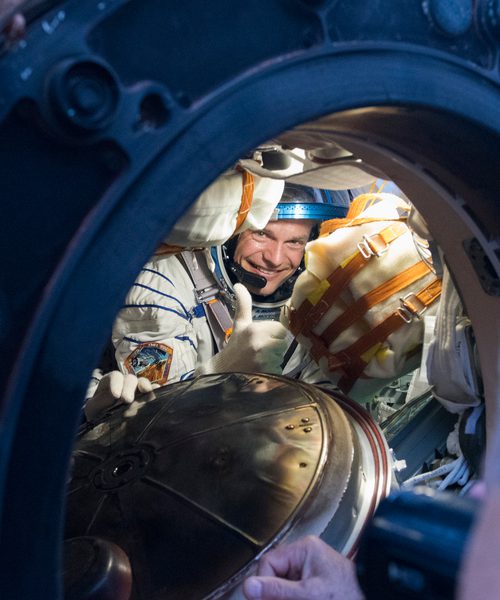
Mission to Mars
Over the years, there have been many missions to Mars and there is also talk of manned missions to the red planet
Humans are curious by nature, and Mars is just one of the places we look for answers to our many questions. The question of whether there is life elsewhere in the universe other than Earth is particularly interesting to explore on the red planet.
Mars is similar to Earth in many ways, but it can get down to -140 degrees Celsius at night and the atmosphere, consisting mainly of carbon dioxide, is very thin. At the surface, it's actually 100 times thinner than Earth's. These are just some of the things that make it very difficult to do research on Mars - especially during a manned mission.
Life on Mars can be divided into two categories. There is research looking for existing life on Mars, including searching for liquid water, but there are also scientists conducting experiments to prepare for manned missions to Mars.
To start from the beginning, we first take a closer look at the unmanned missions to Mars that can provide data that can be used to learn more about our red neighbour. Including whether there has ever been life?
The road to Mars
The US was behind Mariner 4, the first successful mission to Mars in 1964, after the Soviet Union had launched five missions that all failed. Mariner 4 sent 21 images back to Earth. This was followed by a number of missions from both the US and the Soviet Union that flew past Mars and delivered images and other data back to Earth.
In 1971, the first man-made object landed on the surface of Mars. It was a Soviet lander that functioned for 20 seconds before breaking down. In 1976, the US landed a lander that worked for a few years.
In 1997, the US landed the first rover on the surface of Mars. It was the Sojourner rover from the Mars Pathfinder mission to further investigate the geology of Mars. A rover is a robot that can move on the surface.
Europe comes along
In 2003, it was finally Europe's turn to explore Mars. It happened with Mars Express, which orbited the planet. On board was a lander, Beagle 2, which unfortunately crashed.
Science on wheels
The most famous missions to Mars are probably those involving rovers. Rovers are a great way to explore a planet. They are mobile, which means they can survey different locations both for diversity but also to reduce uncertainty in general measurements.
Among the most well-known rovers are Spirit, Opportunity and Curiosity. The three rovers have all investigated geology. Spirit was declared dead in 2011, but Opportunity and Curiosity are still working full-time.

Opportunity is currently in a huge crater, which it is currently investigating, while Curiosity is investigating sandbanks, among other things. It is the first study of its kind away from Earth. Curiosity has already given us many important discoveries. For example, it proved that there were once living conditions on Mars by finding ancient lake deposits.
Long lifespan
Most missions to Mars and elsewhere have a long lifespan. It was instruments aboard the Mars Reconnaissance Orbiter (MRO) that in 2015, 10 years after its launch, revealed that there is still liquid water on Mars. The liquid water is found in very small amounts and is different to what we see on Earth. Opportunity had a planned mission time of 90 days and has now been travelling for more than 10 years.
It continues
In March 2016, another exciting mission was launched to Mars. ExoMars is a joint mission between ESA and the Russian space agency Roskosmos and consists of two sub-missions. The first mission launched now consists of an orbiter and a lander, with a second mission to follow in 2020, which will include an orbiter and a rover.
The current mission consists of the Trace Gas Orbiter (TGO) and the Schiaparelli lander. Trace Gas Orbiter's primary task is to collect data to better understand whether small concentrations of methane and other atmospheric gases could be a sign of biological or geological activity.
Schiaparelli's tasks are very versatile. Instruments on board will study electrical fields on the surface of Mars, but also atmospheric conditions such as density and wind. In addition, many of the investigations will be tests to see what happens during the landing and what works and doesn't work. The lessons learnt will be used in the later rover mission.
ExoMars also has Danish participation. The Danish company Terma has supplied the power supply for ExoMars. They have made a name for themselves in connection with the Rosetta mission to Comet 67P, where they also supplied the power supply.
Manned missions
In the future, we will be doing even more advanced explorations of Mars with manned missions. There are two missions in particular that have gained attention for their plans to send humans to Mars. These are NASA's Journey to Mars and the private project Mars One.
Mars One
Mars One is not a scientific project, yet it has received a lot of attention. It's a flawed and frivolous project, but it's an interesting look at what private space travel can be.
Mars One started in the Netherlands in 2012, where anyone in the world could sign up to be sent to Mars, never to return to Earth. Over 200,000 people signed up, but it wasn't long before the project was criticised.
Mars One has been criticised by scientists, engineers and aerospace experts for being an unrealistic project. In particular, it has been criticised for a highly optimistic timeline, inability to overcome technical and financial challenges, and its ethics.
Small rockets and rash decisions
Specifically, the rocket they plan to use for the launch is very small compared to what they want to achieve. They will only be able to send a small payload to Mars. Researchers from the renowned American university MIT believe that it will take more than twice as many launches before there are enough spare parts on Mars to build the base colony. This would mean almost doubling the budget.
The fine-grained Martian dust can also get everywhere, and it has been proven that Moon dust, for example, can cause allergic reactions, which can also be the case with Martian dust. In addition, there is a greater radiation hazard on Mars as the planet has no magnetic field to protect against the Sun's rays.
Mars One has also not properly taken into account problems with food production, water and light.
Humans as laboratory animals
Because Mars' atmosphere is so hostile to humans, the crew would spend a lot of time on the base, where there is not much space. The loneliness and other human consequences of living the rest of your life on another planet are also not taken seriously by Mars One.
These are just some of the reasons why Mars One is not considered a serious project and many doubt that they will ever get to Mars. In contrast, NASA's plans are more realistic.

NASA's Journey to Space
NASA is developing equipment and capabilities that will enable a manned mission to Mars in the 2030s. It is important to realise that NASA's mission is a short-term scientific mission and not a lifelong colonisation of Mars, as proposed by Mars One.
New technical standards
A lot of work needs to be done before NASA is ready to send humans to Mars. Right now they are hard at work developing a space suit they call Orion and a special launch system, SLS (Space Launch System). The first unmanned launch of Orion with SLS is planned for 2018.
In addition to the technical development, they are also working on the physiological and biological challenges. One of the major breakthroughs was when astronauts on the International Space Station managed to grow lettuce in space. This can give scientists a better insight into how to grow crops away from Earth.
The International Space Station is an important research laboratory
NASA draws on their experience from, among other things, the work being done on the International Space Station. Here, astronauts conduct experiments that will help develop the technologies and communication systems that will be used for long-term manned missions to Mars and elsewhere.

Onboard the ISS, experiments are also being conducted to investigate what happens to the human body during long periods of weightlessness, which is important when travelling to Mars where the travel time is very long. Two astronauts recently spent almost a year aboard the International Space Station to allow researchers to further investigate the effects.
NASA spends much more money and many more (and better) resources on their Mars project, making it much more likely that they will be the first to send a manned mission to Mars.







